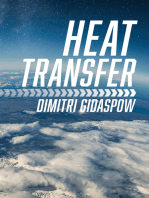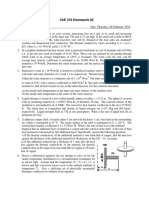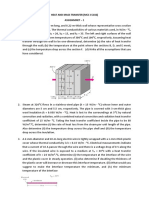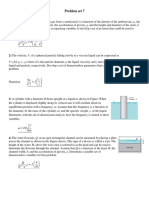Problem Set
Uploaded by
Zac IriberriProblem Set
Uploaded by
Zac IriberriHeat Transfer
57048
Schedule: WF 3-4 P.M.
Problem Set No. 1
Deadline of Submission is until 3 P.M. only of March 31, 2021.
1. A steel pipe (k = 50 Wm-1K-1) of inner diameter 20 cm and thickness 5 mm carries chilled
water at 5 °C. The pipe is insulated on the outside with a layer of fiberglass (k = 0.035 Wm-
1 -1
K ) of thickness 6 cm. The convective heat transfer coefficient between the chilled water
and the inner pipe surface is 100 Wm-2K-1. The heat transfer coefficient between the outer
surface and the ambient air at 28 °C is 20 Wm-2K-1. Calculate the rate of heat flow from
the ambient to the chilled water over a length of 5 m of pipe.
2. An electric cable has a 2 mm diameter copper wire encased in a 3 mm thick insulator of
thermal conductivity 0.2 Wm-1K-1. The heat transfer coefficient between the outer surface
of the insulator and the ambient at 30 °C is 40 Wm-2K-1. If the maximum temperature limit
for the insulator is 150 °C, determine the maximum heat generation rate that can be allowed
in the wire.
3. The boiling temperature of nitrogen at atmospheric pressure at sea level ( 1 atm pressure)
is -196 °C. Therefore, nitrogen is commonly used in low-temperature scientific studies
since the temperature of liquid nitrogen in a tank open to the atmosphere will remain
constant at -196 °C until it is depleted. Any heat transfer to the tank will result in the
evaporation of some liquid nitrogen, which has a heat of vaporization of 198 kJ/kg and a
density of 810 kg/m3 at 1 atm.
Consider a 3-m diameter spherical tank that is initially filled with liquid nitrogen at 1 atm
and -196 °C. The tank is exposed to ambient air at 15 °C, with a combined convection and
radiation heat transfer coefficient of 35 Wm-2K-1. The temperature of the thin-shelled
spherical tank is observed to be almost the same as the temperature of the nitrogen inside.
Determine the rate of evaporation of the liquid nitrogen in the tank as a result of the heat
transfer from the ambient air if the tank is (a) not insulated, (b) insulated with 5-cm-thick
fiberglass insulation (k = 0.035 Wm-1K-1), and (c) insulated with (2-cm-thick
superinsulation which has an effective thermal conductivity of 0.00005 Wm-1K-1. Also, (d)
compare the critical radius of insulation of the two insulators in (b) and (c).
Figure 1 Illustration for Problem 3.
You might also like
- 2.6.2 - Transport Processes (Additional Problems)No ratings yet2.6.2 - Transport Processes (Additional Problems)2 pages
- Universidad de Pamplona: Programa de Ingeniería MecánicaNo ratings yetUniversidad de Pamplona: Programa de Ingeniería Mecánica1 page
- Problem Set - I: Shri Ramswaroop Memorial UniversityNo ratings yetProblem Set - I: Shri Ramswaroop Memorial University4 pages
- Follow The Homework Submission Guidelines!!!No ratings yetFollow The Homework Submission Guidelines!!!1 page
- Me52102 - HMT Sheet - I Conduction Jul-Dec'23No ratings yetMe52102 - HMT Sheet - I Conduction Jul-Dec'233 pages
- Files-5-Exams Quizzes Examples Problems Me315No ratings yetFiles-5-Exams Quizzes Examples Problems Me31544 pages
- Files-5-Exams Quizzes Examples Problems Me315No ratings yetFiles-5-Exams Quizzes Examples Problems Me31544 pages
- Be - Mechanical Engineering - Semester 5 - 2019 - November - Heat Transfer HT Pattern 2015 PDFNo ratings yetBe - Mechanical Engineering - Semester 5 - 2019 - November - Heat Transfer HT Pattern 2015 PDF4 pages
- SRM University: Part - A Answer ALL Questions (10 X 2 20 Marks)No ratings yetSRM University: Part - A Answer ALL Questions (10 X 2 20 Marks)2 pages
- Quiz #4 - UZB314E Heat Transfer (22822) 2023-2024 Spring SemesterNo ratings yetQuiz #4 - UZB314E Heat Transfer (22822) 2023-2024 Spring Semester2 pages
- Thermal Properties of Matter and Heat Transfer _ Practice Sheet __ JEE ChallengersNo ratings yetThermal Properties of Matter and Heat Transfer _ Practice Sheet __ JEE Challengers9 pages
- Heat and Mass Transfer (MCC 15102) Assignmnet - 1: A F B C D ENo ratings yetHeat and Mass Transfer (MCC 15102) Assignmnet - 1: A F B C D E4 pages
- Encyclopaedia Britannica, 11th Edition, Volume 8, Slice 3 "Destructors" to "Diameter"From EverandEncyclopaedia Britannica, 11th Edition, Volume 8, Slice 3 "Destructors" to "Diameter"No ratings yet
- Objective Questions (Food Process Engg)No ratings yetObjective Questions (Food Process Engg)256 pages
- 14 Cosmology: Answers To Exam Practice QuestionsNo ratings yet14 Cosmology: Answers To Exam Practice Questions5 pages
- 2018 JC2 H2 Physics SA2 Nanyang Junior CollegeNo ratings yet2018 JC2 H2 Physics SA2 Nanyang Junior College22 pages
- ChE 3111 Module 4 Heat Transfer with Phase ChangeNo ratings yetChE 3111 Module 4 Heat Transfer with Phase Change20 pages
- Evaluating Heat Exchanger Performance ResearchNo ratings yetEvaluating Heat Exchanger Performance Research9 pages
- PHYS SCI 2025 National ANNUAL TEACHING PLAN GR 10 ENG FOR 2025No ratings yetPHYS SCI 2025 National ANNUAL TEACHING PLAN GR 10 ENG FOR 202512 pages
- The Unified Electromagnetic Field: Miles MathisNo ratings yetThe Unified Electromagnetic Field: Miles Mathis7 pages
- Enhancement of Heat Transfer Rate of Tube in Tube Helical Coil Heat ExchangerNo ratings yetEnhancement of Heat Transfer Rate of Tube in Tube Helical Coil Heat Exchanger7 pages
- 29-12-2024_Sr.S60_Elite, Target & LIIT-BTs_Jee-Main-GTM-11&06_KEY & Sol'SNo ratings yet29-12-2024_Sr.S60_Elite, Target & LIIT-BTs_Jee-Main-GTM-11&06_KEY & Sol'S10 pages
- Problem 1: Gaussian Beams To The Moon: EE 231, Lasers Spring 2007 Problem Set 1 Due 5PM 18 AprilNo ratings yetProblem 1: Gaussian Beams To The Moon: EE 231, Lasers Spring 2007 Problem Set 1 Due 5PM 18 April2 pages
- High Resolution Wide-Angle Compact Catadioptric Telescope Onboard MicrosatelliteNo ratings yetHigh Resolution Wide-Angle Compact Catadioptric Telescope Onboard Microsatellite141 pages
- A Discovery That Shook The World: The Nobel Prize 2017 in PhysicsNo ratings yetA Discovery That Shook The World: The Nobel Prize 2017 in Physics1 page
- Physics II XII Long All Answer by Mustafa Mir 1717559423No ratings yetPhysics II XII Long All Answer by Mustafa Mir 17175594233 pages
- Alfa Laval - Gasketed Plate Heat ExchangersNo ratings yetAlfa Laval - Gasketed Plate Heat Exchangers3 pages
































































































